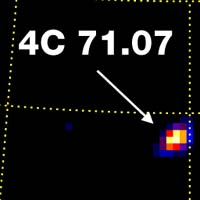Portal:Radiation astronomy/X-ray astronomy article/22


A quasi-stellar radio source (quasar) is a very energetic and distant galaxy with an active galactic nucleus (AGN). QSO 0836+7107 is a Quasi-Stellar Object that emits baffling amounts of radio energy. The radio signal is caused by electrons spiraling along the magnetic fields. These electrons can also interact with visible light emitted by the disk around the AGN or the black hole at its center, and that pumps them to emit X- and gamma-radiation.
On board the Compton Gamma Ray Observatory (CGRO) is the Burst and Transient Source Experiment (BATSE) which detects in the 20 keV to 8 MeV range. QSO 0836+7107 or 4C 71.07 was detected by BATSE as a source of soft gamma rays and hard X-rays. "What BATSE has discovered is that it can be a soft gamma-ray source". QSO 0836+7107 is the faintest and most distant object to be observed in soft gamma rays. It has already been observed in gamma rays by the Energetic Gamma Ray Experiment Telescope (EGRET) also aboard the Compton Gamma Ray Observatory.
